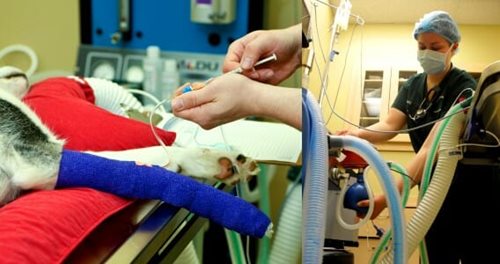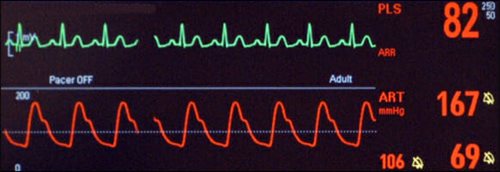At our hospital, each patient has one or more technicians dedicated full time to your pet’s anesthetic monitoring under the care of the veterinarian. These technicians are with your pet from induction (initiation of anesthesia) right through to their full recovery.
We take the safety of your pet under anesthesia very seriously. Each patient undergoing anesthesia has a specific drug protocol tailored individually based on their species, age, breed, and the procedure in which they are undergoing.
Anesthetic maintenance and monitoring are crucial for a successful surgical procedure. As such, in addition to a technician dedicated to hands-on monitoring including pulse quality (to identify blood pressure and arrythmias), mucous membrane colour and capillary refill time, and other parameters such as jaw tone and the presence of a palpebral reflex (to assess anesthetic depth), the anesthetic patient is hooked up to our monitors which are at all times monitoring over eight different parameters.
Every patient at Westbridge Veterinary Hospital undergoing a procedure requiring anesthesia is placed on intravenous fluids. This is important in maintaining blood pressures, the importance of which is outlined below. In addition, it provides intravenous access which is crucial to the administration of life saving drugs in the event of an anesthetic emergency.

Blood Pressure Monitoring
Blood pressure monitoring is essential to a patient under anesthesia. Blood pressure is the driving force for blood flow (perfusion) through capillaries that supply oxygen to organs and tissue beds of the body. Low blood pressure results in decreased oxygen delivery, resulting in the death of important cells and organ damage, most sensitively the kidney and brain. Because lowered blood pressure is a common side effect of many anesthetic drugs, monitoring these values under anesthesia is crucial. At Westbridge, a state-of-the-art non-invasive blood pressure monitor is hooked up to your pet at all times, using the two leaders in non-invasive blood pressure monitoring. Changes in blood pressure can be determined quickly and accurately, allowing for appropriate interventions, increasing the safety for your pet.
Capnography – CO2 (carbon dioxide) Monitoring
CO2 monitoring is extremely valuable to a patient under anesthesia. It is the most accurate tool conventionally available to assess the respiratory system in a patient under anesthesia. Inadequate ventilation (or ‘breathing’) can result in increased CO2 levels, which can cause arrythmias, altered blood flow to the brain, and potentially death. This is particularly important to patients with airway disease (such as asthma), or to overweight animals. CO2 is also the most accurate tool we have to assess cardiac output, or the strength and effectiveness of the hearts contractions.
Temperature
Anesthesia always results in a dramatic reduction in body temperature, particularly in long procedures. Decreased body temperatures is associated with prolonged recovery and increase in post-surgical infections. Every anesthesia patient is monitored through an esophageal thermometer which gives an accurate representation of core body temperatures. Every anesthetic patient is provided with a Bair Hugger, a forced-air device that safely fills a blanket around the patient with warm air at 39 degrees to maintain body temperatures extremely effectively.
ECG / EKG / Electrocardiogram
An electrocardiogram detects and amplifies tiny electrical changes on the skin that are caused when the heart muscle “depolarizes” during each heart beat. This helps to detect arrhythmias which can be caused by anesthesia or heart disease, and when present can be potentially fatal if left untreated.
Heart and Respiratory (Breathing) Rate
Heart rate and respiratory rate are measure constantly though an anesthetic procedure. These values are useful for many reasons, including assessing anesthetic depth, body temperature, drug reactions, etc. These are monitored both by our anesthetic monitor, as well as by the technician by visualizing and characterizing each breath, as well as through a stethoscope.
SPO2 – Oxygen Saturation
SPO2 is a measure of the amount of oxygen that is dissolved in the blood stream, carried by red blood cells. This ensures that a patient is receiving adequate amounts of oxygen. Lowered O2 can be a result of inadequate breathing, lung disease, excessive intravenous fluids, bleeding, and much more.
The Human Touch
Arguably as important as any monitored parameter is the presence of a trained technician managing your pets anesthesia at all times, under the supervision of the veterinarian. Our technicians undergo year round training and continuing education to further their anesthesia skills, and to stay up to date with modern anesthesia. Their presence is imperative to the safety of your pet, and to verify the accuracy of the various monitors. Changes in the parameters monitored can be assessed immediately, allowing various interventions necessary, such as adjusting the depth of anesthesia, or to deliver necessary medications.

Anesthetic Machine
Our anesthetic machines are designed specifically for the use in small animal anesthesia. Our machines are tested every morning by our technicians prior to surgery to ensure their function and accuracy. Oxygen flow rates, re-breathing bag sizes, and circuit type are carefully modified for each patient.
Coaxial anesthetic tubing on anesthetic machines (below) helps retain body heat while the pet is under anesthetic.

